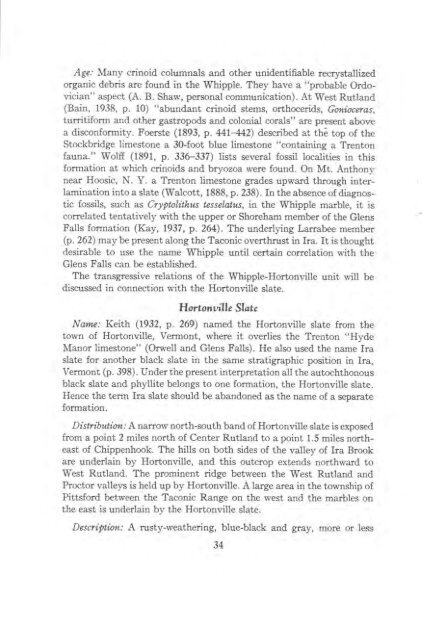STRATIGRAPHY AND STRUCTURE CASTLETON AREA VERMONT
STRATIGRAPHY AND STRUCTURE CASTLETON AREA VERMONT
STRATIGRAPHY AND STRUCTURE CASTLETON AREA VERMONT
You also want an ePaper? Increase the reach of your titles
YUMPU automatically turns print PDFs into web optimized ePapers that Google loves.
Age: Many crinoid columnals and other unidentifiable recrystallized<br />
organic debris are found in the Whipple. They have a "probable Ordovician"<br />
aspect (A. B. Shaw, personal communication). At West Rutland<br />
(Bain, 1938, p. 10) "abundant crinoid stems, orthocerids, Gonioceras,<br />
turritiform and other gastropods and colonial corals" are present above<br />
a disconformity. Foerste (1893, p. 441-442) described at th top of the<br />
Stockbridge limestone a 30-foot blue limestone "containing a Trenton<br />
fauna." Wolff (1891, p. 336-337) lists several fossil localities in this<br />
formation at which crinoids and bryozoa were found. On Mt. Anthony<br />
near Hoosic, N. Y. a Trenton limestone grades upward through interlamination<br />
into a slate (Walcott, 1888, p. 238). In the absence of diagnostic<br />
fossils, such as Cryptolithus tesselatus, in the Whipple marble, it is<br />
correlated tentatively with the upper or Shoreham member of the Glens<br />
Falls formation (Kay, 1937, p. 264). The underlying Larrabee member<br />
(p. 262) may be present along the Taconic overthrust in Ira. It is thought<br />
desirable to use the name Whipple until certain correlation with the<br />
Glens Falls can be established.<br />
The transgressive relations of the Whipple-Hortonville unit will be<br />
discussed in connection with the Hortonville slate.<br />
Hortonville Slate<br />
Name: Keith (1932, p. 269) named the Hortonville slate from the<br />
town of Hortonville, Vermont, where it overlies the Trenton "Hyde<br />
Manor limestone" (Orwell and Glens Falls). He also used the name Ira<br />
slate for another black slate in the same stratigraphic position in Ira,<br />
Vermont (p. 398). Under the present interpretation all the autochthonous<br />
black slate and phyllite belongs to one formation, the Hortonville slate.<br />
Hence the term Ira slate should be abandoned as the name of a separate<br />
formation.<br />
Distribution: A narrow north-south band of Hortonville slate is exposed<br />
from a point 2 miles north of Center Rutland to a point 1.5 miles northeast<br />
of Chippenhook. The hills on both sides of the valley of Ira Brook<br />
are underlain by Hortonville, and this outcrop extends northward to<br />
West Rutland. The prominent ridge between the West Rutland and<br />
Proctor valleys is held up by Hortonville. A large area in the township of<br />
Pittsford between the Taconic Range on the west and the marbles on<br />
the east is underlain by the Hortonville slate.<br />
Description: A rusty-weathering, blue-black and gray, more or less<br />
34













